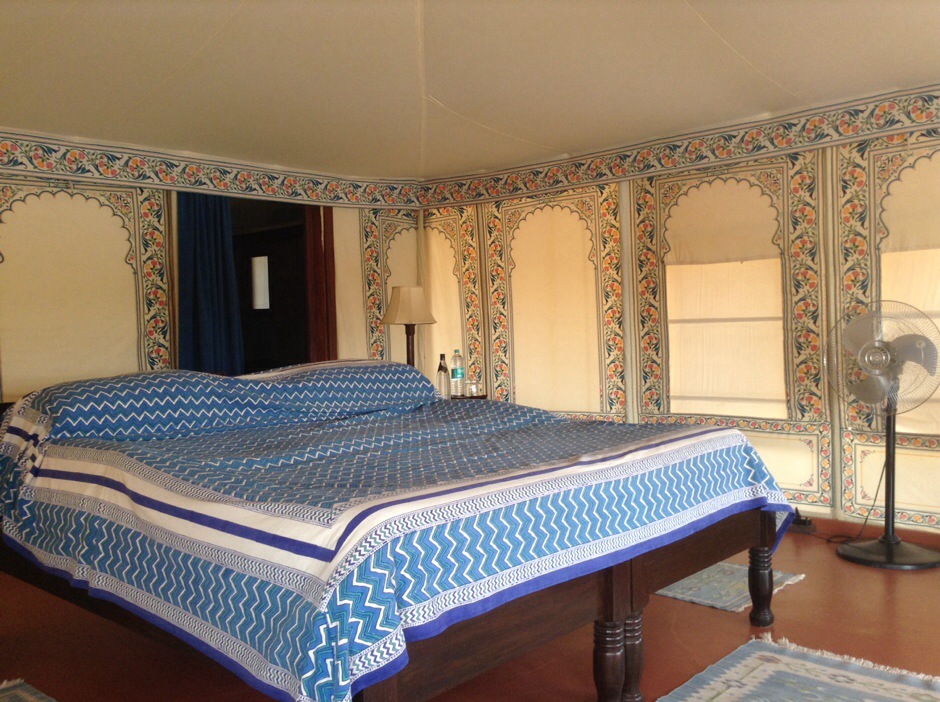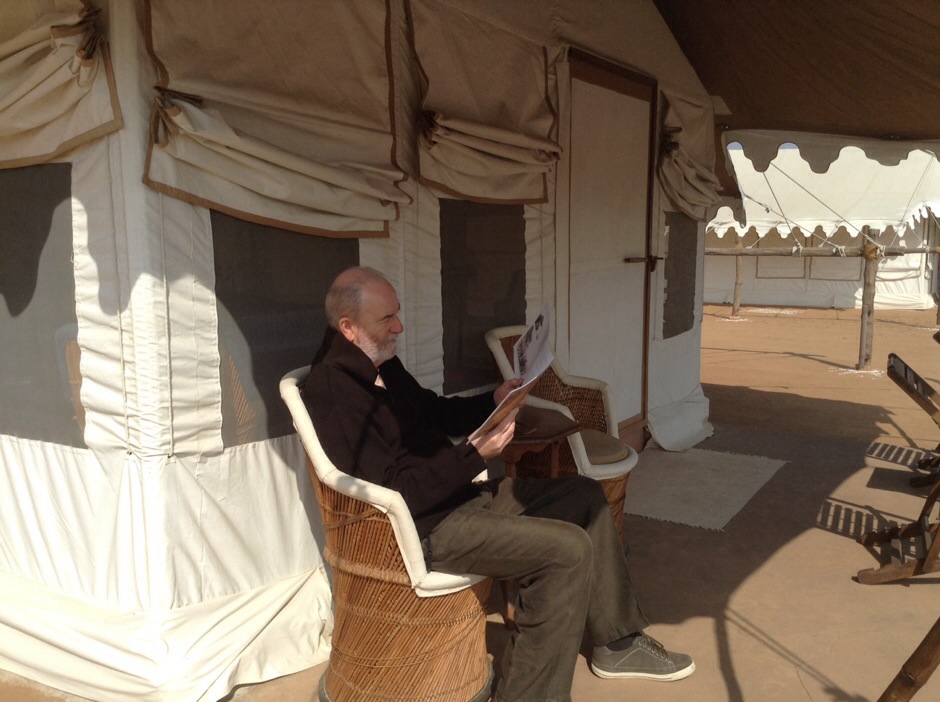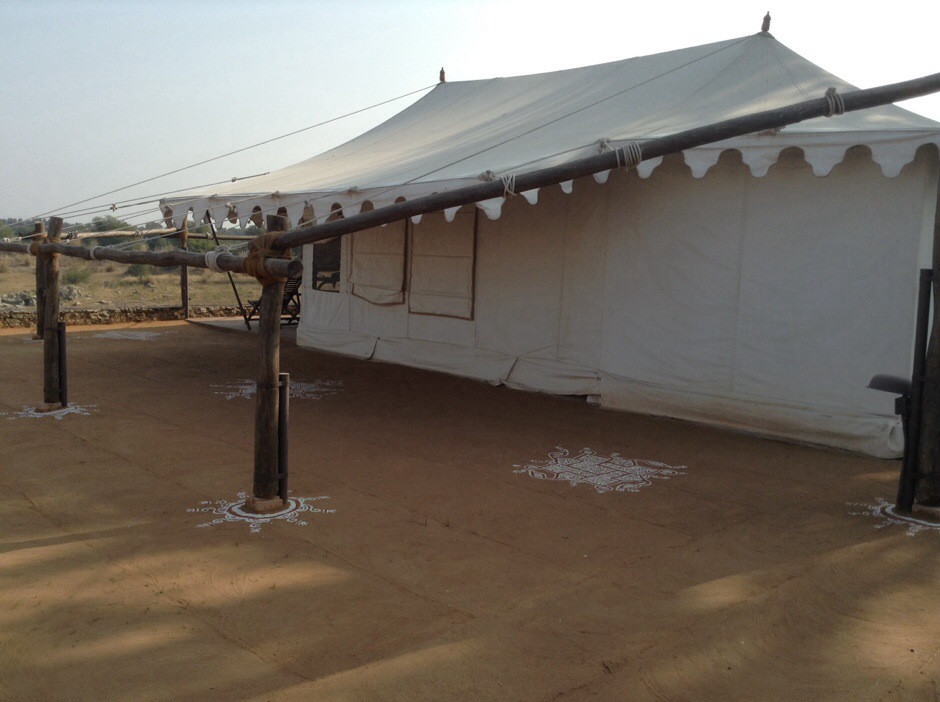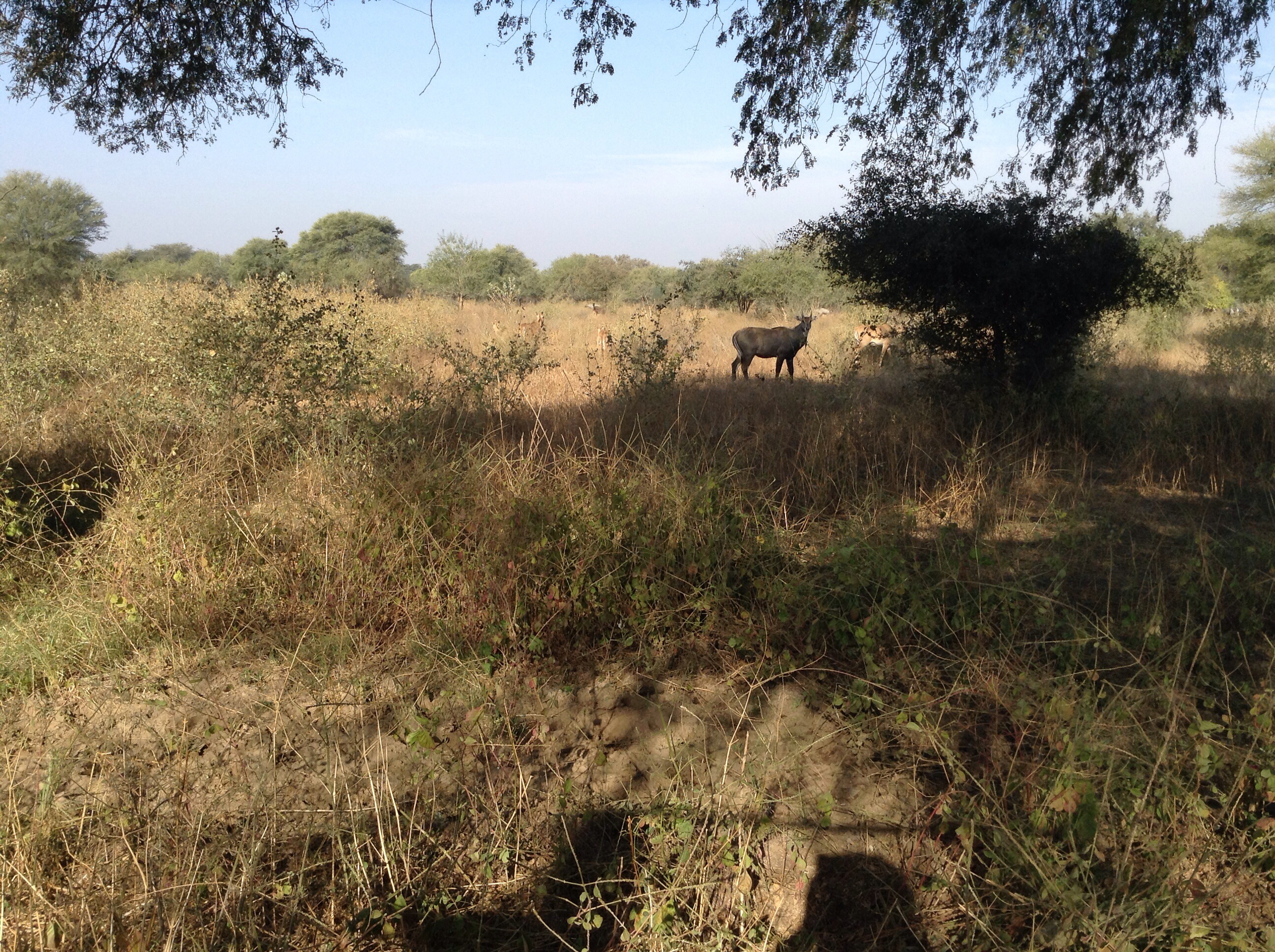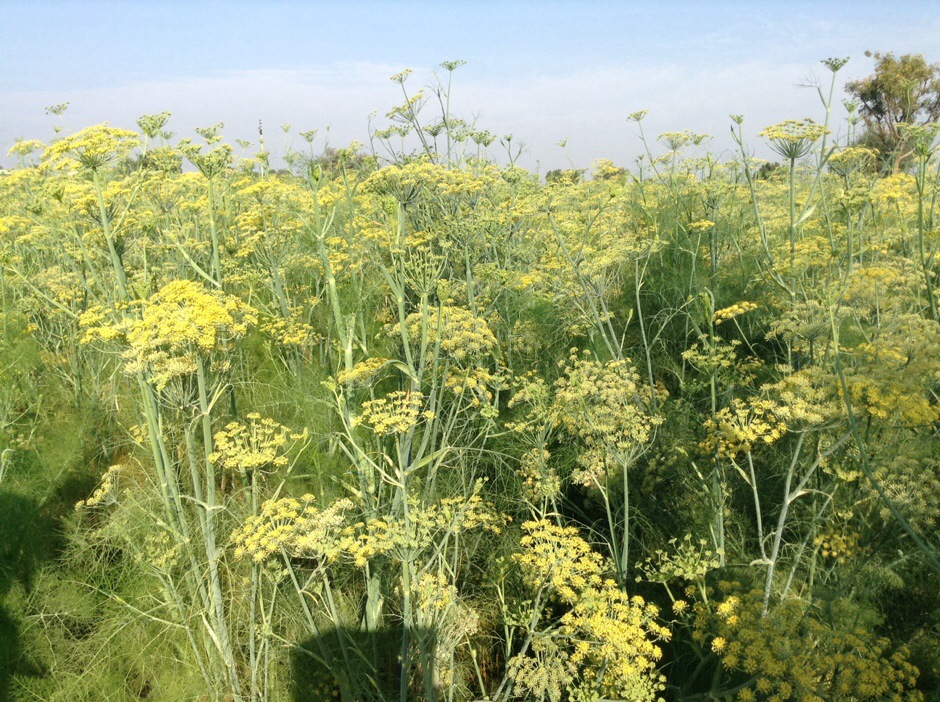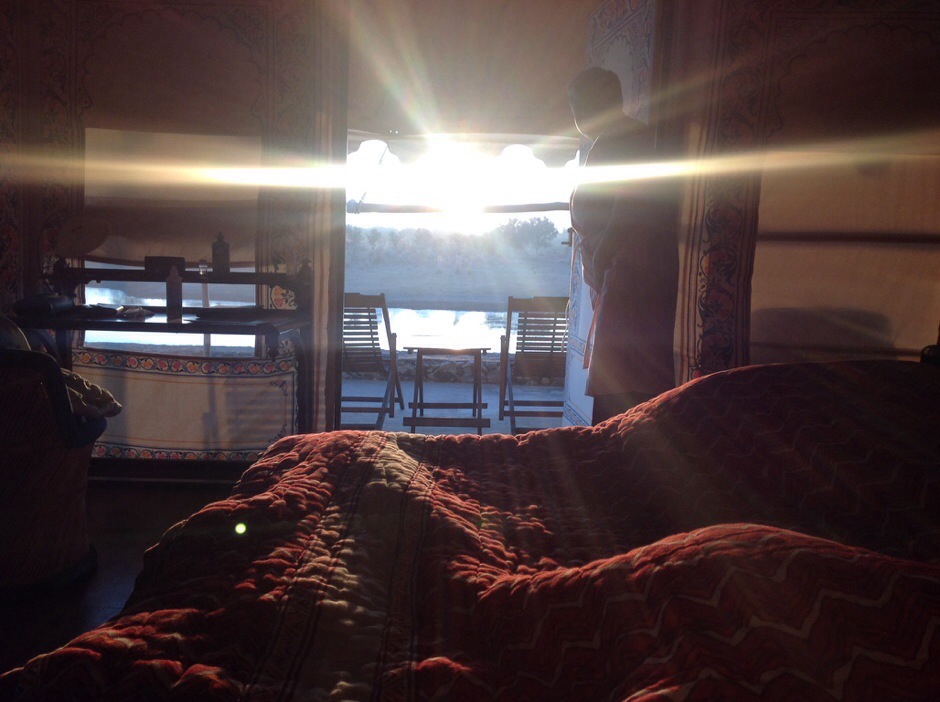This is a belated post because we have not had wifi for 3 days.
We left Jodhpur at about 9h30—the market area was much quieter & so it was much easier to get out than getting in had proved. We headed North East on a relatively good Tarmac road. Traffic was relatively light but we had the usual cow avoidance slaloms but in addition we had to swerve around camels at one stage.
We passed by a railway line under construction & it was really strange to see women working along side the men, in fact there were probably more women than men. What is even stranger is that the women are all wearing brightly coloured saris & carrying spoil away in baskets on their heads. According to Vikram they work a 9 til 5 day with 1 hour off for lunch. There is no doubt that the temperatures are lower here but during the day it is very pleasant & around 22 degrees. This is great for holidays but I wouldn’t like to be doing manual labour. Every village we go through the kids all wave. Just before we reached our next hotel, Vikram stopped to buy something & I was able to get great photos of the local bicycle repair shop & the sweet shop next door.
There are many motor bikes here & they usually have more than 1 person aboard. The sari clad ladies ride pillion side-saddle style &often there is a small child &/or shopping involved too. The highest number we have seen on one bike is 4 people ( record held by Cambodia where we counted 7) but the highlight has to be 2 men & a pig that we passed the other day. Doug was able to capture that shot on the camera so can’t post it—–sorry.
We are now staying at a Nature Reserve/farm about halfway(ish) between Jodhpur & Jaipur. The contrast between here & Jodhpur is immense. The great great grandfather of the 2 brothers who now run the Reserve decided to build a dam in the late 1800’s thus converting previously barren land into an oasis. He encouraged folks to come & use the water & was therefore responsible for establishing a sustainable local community. The dam is named Chhatra Sagar in his memory. In the early 1900’s it became a popular venue for hunting parties & the like with people sleeping in tents. The current generation have established a luxury tented resort & we are now glamping on top of the dam in our very own tent. There are about 12 tents in total with a dining tent & Lounge area. We have all mod cons except wifi & have just been served a rather sumptuous lunch. We have a nature walk planned for this afternoon & a hill climb to see the sun go down.
We did a 3 hr bird spotting walk around the lake & saw the sun go down behind the tents. As well as birds we saw antelope & wild boar. The 2 guides were able to spot the birds so easily & set up a telescope so that we could see them too. We also had a pair of binoculars each & we were both surprised by the enormous variety of birds to see. It was a hugely enjoyable & very different afternoon. At least I don’t feel so guilty about having a big lunch—we must have walked a good 5 or 6 km in total. We were accompanied by a Great Dane & 2 terriers—lovely dogs who seemed to enjoy their afternoon too.
Now we are getting ready for dinner—more of that later.
We met up with an Australian couple + 4 kids who are here on holiday. She adores France & they are going to rent a chalet in the Alps next winter for 7 weeks. We enjoyed a G & T together around a bonfire before dinner. Dinner —- again a culinary masterpiece—no choice menu makes it so much easier—especially when a mini bonfire is placed at your feet to keep you warm. The sides of the dining tent had been lowered so the wind was less noticeable. We tottered back to our tent to find that electric fires had been plugged in & we had a hot water bottle each in the bed—so cosy & it is only 21h30!!!! Coffee is ordered for 7h30 & so another day will begin.
Slept like a log, sent to sleep by the call of deer( rutting season) & the jackals. We were warm & toasty all night long. Coffee arrived as promised & so another day begins. It was hard to poke your toes out of the bed but Doug gallantly switched the fires on again. It is much windier today so feels very fresh, I wore my warm outer clothes for the first time. Incidentally we have rediscovered pomegranates, since for both of us childhood memories were of picking out seeds from inside a dry husk. The pomegranates here are delicious & nothing like those of childhood. We are off to visit the local village this morning.
Our village & farm trip was amazing. Firstly our guide Raj, one of the owners, explained how land was divided after independence in 1947. His family lost quite a bit of land despite having been the ‘founding fathers’ of the area. Land was divided & distributed depending on how fertile it was & the more fertile the land then the less you were allowed to keep. However in the modern India land is supporting more & more people mainly because the succession laws are similar to those in France—I.e. equal rights for all the family & whilst the family unit is strong, the risk is that the plots become smaller & smaller as they are sub-divided.
We started with the surrounding farm land & saw the crops that they grow. Irrigation is the main feature & all the water is available because of the construction of the dam. The dam raised the local water table & therefore wells were easier to sink. The fields are all divided by water channels & each part of the field is flooded in succession. The soil is quite sandy so to form the channels it is mixed with animal dung to make a clay like substance. To flood a certain area they simply break the channel wall & then rebuild it once watering is complete. Crops being grown are aniseed, chilies,aubergine, millet,lentils & henna. Henna is an easy crop as it needs no irrigation & lasts for about 18 yrs before it needs replacing. Our guide was surprised to learn that henna is very popular in France.
We then went into the local village that was created when the dam was built. Although the buildings are very simple the layout of the village has been thought out so for example the dust from the potter is not near the building where oil is stored. In this village there is a distinct lack of plastic which is the main pollutant of other places we have been. The villagers gather it up & still throw it away but outside the village boundary! The houses are very simple & we were welcomed into some of them. The local shepherd & his family were happy to show us how they lived. At the potter’s house he actually threw some pots on his wheel & then his wife decorated them. He did all this squatting on the floor & getting the wheel to spin manually on a short sharp piece of wood. His wife also has a sewing machine & makes tarpaulins from used & washed sacks. The village operates on a barter system except for the silversmith who wants cash. The potter makes pots every 6 months & receives grain in return from each house. Some he keeps for his own needs & the rest he sells at market to give him cash so he can pay his electricity & mobile phone bills!!!!
We went into the local school & saw the children learning their sums & letters. They were all very keen to show us their books & the slates on which they were working. Although it is a very simple way of life everybody is happy & no one is hungry. They are poor in our terms but rich in the benefits of family & communal living.
We passed a very peaceful afternoon enjoying the warmth of the sun & watching the animals & birds. At 17h we went up a nearby hill to watch the sunset. Although quite steep it was not a difficult ascent & our guide was the guy from yesterday & his 3 dogs. As we reached the summit we were greated by one of the staff offering us G& T—-couldn’t refuse! The sunset was spectacular after which we wended our way back to await dinner. We passed a happy half-hour talking to 3 American ladies who were more than happy to give us travel tips for USA. Dinner was another culinary feat & we are now back in our warm & cosy tent— even earlier than last night.
Tomorrow we move on to pastures new & another adventure will begin. We will be heading for Jaipur which is a journey of about 5 hrs.
New home at Ribatou
